All 4 entries tagged Rome
View all 13 entries tagged Rome on Warwick Blogs | View entries tagged Rome at Technorati | There are no images tagged Rome on this blog
January 01, 2020
A Bronze Neapolitan Coin and its Relevance to Rome
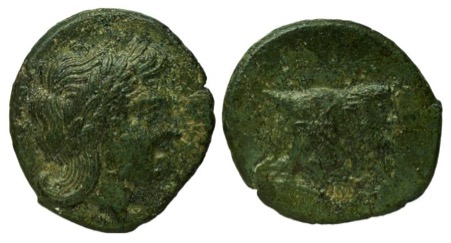
RRC 1/1, Bronze Coin minted in Neapolis (Naples), now in the Bibliothèque nationale de France, 3.03g, 17.7 mm
Obverse: Laureate head of Apollo
Reverse: A man-headed bull, with the legend ΡΩΜΑΙΩΝ (Romano).
This simple bronze coin is part of a collection of bronze and silver coinage discovered in the Naples area, dating to the late fourth century BC. It has often been described as one of the first true ‘Roman’ coins, and as such it is the first entry in Michael Crawford’s Roman Republican Coinage, the standard typology of Roman coins from this period. This is slightly misleading, given that Neapolis (modern day Naples) was not under direct Roman rule at this point and was a Greek speaking city, indeed, the legend on the coin itself is in Greek, despite making reference the Romans.
Neapolis was a fairly old city by this point, as there is evidence to suggest settlement in the Naples region as early as the first millennium BC, forming part of the great migration of Greeks from their heartlands in the east to southern Italy (Magna Graecia), Sicily and further afield in the western Mediterranean. Amongst other things, it is likely that it was the Greeks who first introduced true ‘coinage’ into Italy, in line with the discovery of coin hoards dating back to the sixth century in southern Italy. Therefore it is not surprising that the first example of coinage relating to Rome should have been discovered in a southern, Greek city. But why does the coin say ΡΩΜΑΙΩΝ ((coin) of the Romans)?
By the late fourth century BC, Rome was expanding its political reach down towards the southern end of the Italian peninsula. It was engaged in a series of wars with another Italic people, the Samnites of the south-central spine of Italy, and in this conflict many of the Greek cities of southern Italy were effectively forced to pick a side. The region of Campania, in which Neapolis was located, fell between the Romans and the Samnites and thus turned into a battleground between them. According to Livy, after a power struggle between the pro and anti-Roman factions within Neapolis, the city opened its doors to the Romans and signed a pact of alliance, the Foedus Aequissimum, with them. This is dated to around 326 BC, as the second Samnite war was getting under way, and this has also been taken as the earliest likely date for the coin being struck. It is thus possible that the use of ΡΩΜΑΙΩΝ on the coin was meant to publicise the Roman alliance to the general population, but that still does not explain the immediate reason for the coin being struck.
At this point it should be noted that the production of coinage in ancient states was generally not regularised to the same degree as in modern states. Whilst coins and notes are the predominant representation of physical wealth (and a key means of exchange) in the modern world, this was not the case in antiquity, where wealth might just as easily be represented by precious metals or even cattle; indeed it is interesting to note the similarity of the Latin term for money, pecunia, with the Indo-European root word for cattle, peku. Similarly, minted coinage was not necessarily needed for the purposes of exchange either. The Romans themselves appear to have gotten by without using minted coinage at all up until the third century BC, with small transactions seemingly conducted via the use of so called aes grave, literally rough bronze, nuggets of metal that were not shaped or minted in any fashion. Whilst in the modern world the intense quantity and velocity of financial transactions make it an imperative for central banks and mints to constantly replenish the physical money supply on a regularised basis in order to ensure liquidity, this was less the case in the ancient world where there were generally far fewer financial transactions and where the maintenance of ‘liquidity’ was not a concern of the issuers of money. Therefore, issues of ‘authorised’ coinage by cities tended to be made with a specific ‘goal’ in mind, such as to pay for public works or military campaigns, rather than to provide an easy means of conducting small scale private commerce.
The latter of these two examples provides a strong rationale for why this coin may have been minted. Given the new alliance with the Romans, Neapolis would have entered the war against the Samnites, which meant that the city would have had to pay to raise both troops and ships (for the treaty with Rome stipulated the provision of ships, naval warfare being a Roman weakness at this point) for the duration of the war. Coins represent an easy way of remunerating soldiers and sailors, as it relieves a state of the obligation to provide directly for them; if a soldier or sailor receives his dues in coins, he can use that new found wealth to pay for his own food, drink and other sundry expenses, as opposed to having that supplied by the state. Wars, in the ancient and modern eras, are often associated with large expansions of the money supply so as to pay for armies - the severe collapse of the value of Roman coinage during the ‘Crisis of the Third Century AD’ has been associated with large scale minting by various aspirants for the imperial throne in order to win and maintain the support of the soldiery. To return to Neapolis, minting this and other coins provided the city with a means to fund its obligation to the Roman alliance, which seems a sensible explanation for the profusion of Neapolitan coinage towards the end of the third century, a period of prolonged warfare in southern Italy.
This idea in turn provides an interesting link to the Roman ‘adoption’ of coinage in the third century. As Rome grew to be major power in the Italian peninsula and beyond, the amount of warfare that it engaged in inevitably increased; conflict with the Samnites in the fourth century would be followed by wars with Pyrrhus of Epirus and Carthage in the third century, wars that necessitated long military campaigns. Given that (even prior to the full professionalization of the military under Marius), the Roman state provided a stipendium to its troops, the amount paid out as part of this would likely have increased immeasurably during the long years of war in the third century, which perhaps explains why the Romans finally adopted coinage wholesale, as a utile means of providing the stipendium.
Returning to the coin itself, aside from the legend on it, the imagery is largely traditional and displays continuity with earlier Neapolitan coin issues. The bull-headed man on the reverse is a staple not just of Neapolitan coinage but of other coins of Magna Graecia, and has often been taken as a reference to the process of synoecism between Greek colonists and local Italic peoples, the bull being a traditionally Italic symbol (one later used on the coinage of Rome’s rebellious Italian allies during the Social War). On the obverse there is a depiction of the god Apollo, whom we are told by later poet Statius was among the patron gods of Neapolis, so again this is not a hugely surprising piece of imagery. It could thus be argued that the coin is representative of a fulcrum point in the history of Magna Graecia; Greek language and traditional Greek and Graeco-Italic symbolism remains on the coin, but the reference to the Romans is a clear sign of the region’s gradual absorption into the Roman sphere of influence and thus foreshadows the profound social changes that would affect both the Greek cities of the south and Rome itself in the coming century.
 |
This month’s entry was written by Ieuan Luke. Ieuan graduated from Warwick in 2017 and is still interested in the ancient world, focusing primarily on ancient economies and the reception of antiquity in Europe and Russia.
June 01, 2018
A Roman Token Mould in Harvard
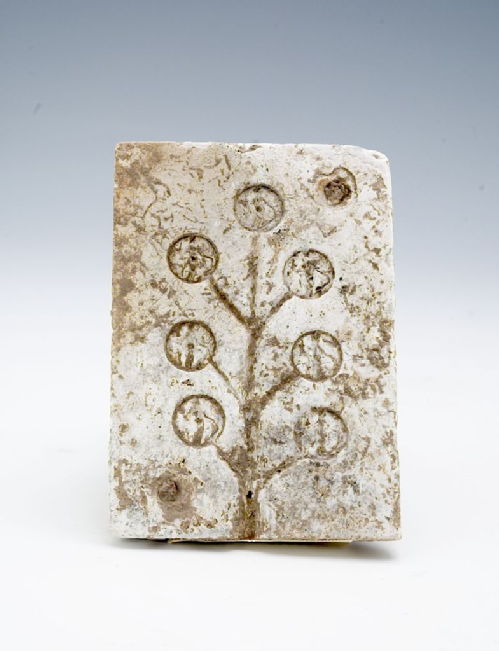 |
| Roman Token Mould from Harvard Art Museums, 2008.118 |
Amongst the McDaniel bequest to Harvard Art Museums in Boston is one half of a mould made of palombino marble. Shown here, this piece is one of the numerous moulds of this type used to cast Roman lead tokens. This particular mould half is 10.8x7.6x2.9cm and weighs 389.2g. It would have been used in conjunction with another half to cast seven circular lead tokens of c. 14mm, all carrying an image of the goddess Fortuna holding a cornucopia and rudder (and presumably another image on the other side, engraved on the other half of the mould). It has previously been published in Hirschland and Hammond 1968.
This type of token mould is characteristic of Rome and Ostia, and was donated to Harvard along with McDaniel's collection of Roman lead tokens and other antiquities. We know from McDaniel himself that he purchased his lead tokens (and thus probably also this mould) from the city of Rome. In his memoir, Riding a Hobby in the Classical Lands (p. 71), McDaniel writes:
“For the integrity of one dealer in Rome I can vouch unreservedly and so, as a contrast to some of the rest of my group, I name him here at the end of the chapter, honoris causa, Signore Scalco. His sunny face and smile alone used to lighten the tiny, gloomy shop not far from St. Peter’s in which he exposed for sale his modest stock of classical antiquities. A charming, well-informed Italian was he, who often had unusual things for sale. Thus, it was from him I bought a considerable number of papal medals…. From him, too, came my piombi, those coin-shapes of lead which have so much about them to pique the curiosity and to puzzle the best of scholars as they work on the problem of their various uses. While I almost never saw any customers in the shops of the other small dealers in Rome, Scalco was one who received calls from archaeologists, who liked to chat with him, and also from the proprietors of the more pretentious establishments, who would buy from him in order to sell again. There, too, one might chance at any time upon one of the rough dwellers of the Trastevere who had fished something out of the Tiber which he expected to have identified as modern, or, if good luck were his, to sell as an antiquity. He was just as sure as the most promising customer to receive all the attentions of courtesy and fair treatment; that was Scalco."
 |
|
Cast lead tokens
from Ostia.
|
The mould carries the channels through which molten lead was poured into the token cavaties; the resulting tokens were then broken off to be used (see the picture left for an example of what the resulting cast would have looked like before the tokens were broken off). The mould still contains the iron nails used to fasten both halves of the mould together (in the top right and lower left corners) - this would ensure that both halves of the mould were correctly aligned. The top and bottom sides of the mould carry faint grooves (see image below); it has been suggested that these grooves were created for or by wire that was wrapped around the moulds during the casting process (Pardini et al 2016). The back of the mould is unworked, as many moulds of this type are.
The top right corner of the Harvard mould has an unusual feature: two concentric circles are etched into the material (see image below). The inner circle is 14mm, the precise diameter of the tokens produced by this mould. These two circles may have been an error made by the person producing the mould, or they may in fact provide a clue as to how these moulds were made: perhaps two concentric circles were sketched before a design was carved into the inner circle- here, perhaps, it was decided that this additional token design was not needed. When one looks closely at each of the circular designs, one sees a deep circular depression at the centre, on Fortuna's body. Jack Kroll, in his unpublished catalogue of these pieces, suggested that this depression was caused by the bit of an instrument used for cutting the circular depressions before the designs were engraved (much like the point of a compass). Many Roman lead tokens carry circular protuberances at their centre; the Harvard mould allows us to understand these protuberances were the result of the mould manufacturing process rather than an intentional part of the design.
Images below from left to right: the side of the mould with faint grooves; a close up of the top left corner of the mould showing two concentric circles and a central depression on the body of Fortuna; a Roman lead token from the Harvard Art Museums collection (2008.116.41) with a wreath and a central dot, now understood to be a result of the mould making process.
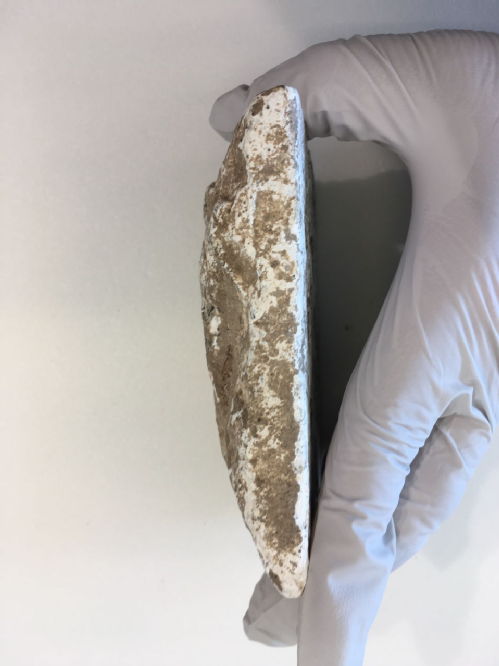 |
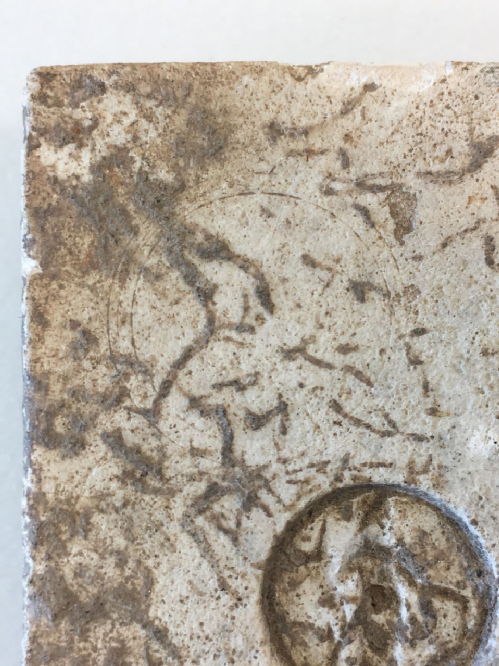 |
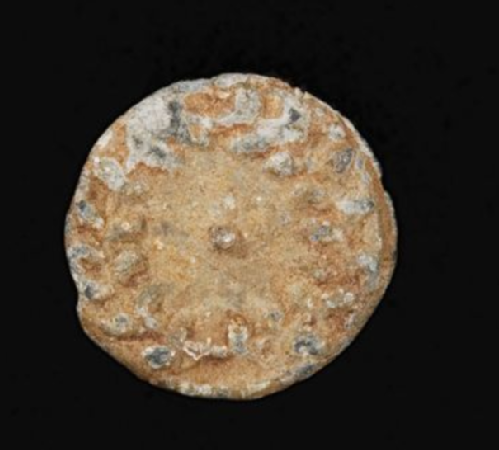 |
This coin of the month was written by Clare Rowan as part of the Token Communities in the Ancient Mediterranean Project.
Select Bibliography:
Hirschland, N. L. and M. Hammond (1968). Stamped Potters' marks and other stamped pottery in the McDaniel Collection. Harvard Studies in Classical Philology 72: 369-382.
Kroll, J. H. (unpublished manuscript). Roman Lead Tokens in Harvard Art Museums.
McDaniel, W. B. (1971). Riding a Hobby in the Classical lands. Cambridge, Mass., Harvard University Printing Office.
Pardini, G., M. Piacentini, A. C. Felici, M. L. Santarelli and S. Santucci (2016). Matrici per tessere plumbee dalle pendici nord-orientali del Palatino. Nota preliminare. In: Le regole del gioco tracce archeologi racconti. Studi in onore di Clementina Panella. ed. A. F. Ferrandes and G. Pardini, Edizioni Quasar: 649-667.
January 01, 2018
The Animal Tokens of Rome
Token are coin-like objects, often made of lead, and interestingly, many examples have been found depicting animals of various species, from lions and elephants, to domestic animals such as horses. Often these items pertain to events organised for entertainment, such as chariot races, hunting, and finally the games themselves, and from studying other depictions of these same animals in Roman art, it becomes clear they may have had a use in these environments.
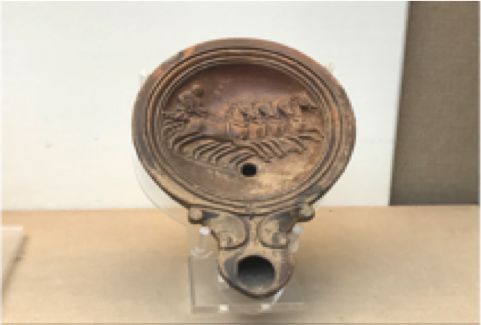 |
 |
|
An oil lamp showing an image of a
charioteer
|
A token from the Ashmolean museum
depicting a charioteer.
|
 |
|
A wax seal, from the British Museum,
depicting a horse and palm branch.
|
Chariot racing was perhaps the most popular sport in the Roman world, as can be seen when Lucian recounts that the “craze for horses is really great, you know, and men with a name for earnestness have caught it in great numbers” (Nigrinus, 29). In Rome, the event was held in the Circus Maximus, which could seat up to 150,000 people, and thus at any given time contain a sixth of the population. Horses feature commonly on tokens in many guises, such showing their domestic function of carrying heavy objects, but also, as seen above, in a more competitive atmosphere of the races. Since such imagery is seen elsewhere, such as an oil lamp, it clearly indicates tokens had a role within the stadia, possibly as entrance tickets for the races. Moreover, some tokens depict horses alongside palm branches. These branches are a symbol of victory, and the very same imagery can be seen on a wax seal from the 1-2nd century AD, also in relation to chariot racing. Thus it could also be suggested that tokens could commemorate a successful day at the races, or have a role in betting. Like today, the Romans would bet on horses, since chariot races involved four different teams, each with their own groups of supporters.
Furthermore, there is also a suggestion that tokens could have had a role in hunting. Hunting had been important in Roman society for centuries, starting as a way to catch food, but later developing into an elite hobby, intended to both train young men for military action, and improve their morality. Some aristocrats had game parks, and there are scenes of the hunt depicted in mosaics, to decorate the domestic space. This indicates how the sport was a popular pastime, and even a status symbol. Some images on tokens are very similar to this mosaic, showing a hunter closing in on a boar, holding his spear aloft. Perhaps therefore, tokens were invites to a hunt, or a commemorative item. This particular image however, could also have come from the games, as boars were hunted both privately, and as part of the entertainment provided in the amphitheatre.
 |
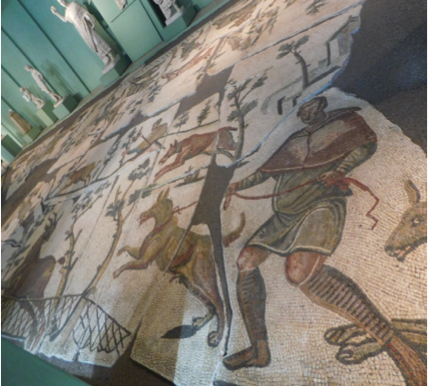 |
| Two scenes from a mosaic which depicts a wild hunt. |
Additionally, the games are perhaps one of the most famous aspects of the Roman world for the modern reader, and their importance can be seen in the way Juvenal suggests all the Roman people wanted was “bread and circuses” (Satires, 10). Alongside the famous gladiators, animal shows, called venationes, were commonly held. During these events, great effort was made to make the colosseum appear like a hunting ground, including the use of scenery, and many animals are recorded as being used, such as big cats, elephants, bears, and herbivores such as boar, deer, and more exotically, zebras. These unfortunate creatures were transported from the conquered provinces, as symbols of Roman superiority over nature, and their empire. Importantly, all these animals can be seen on tokens. Although many tokens are unclear because of the damage they have incurred over the centuries, lions and elephants are instantly recognisable because of their manes and tusks respectively. Elephants were important symbols during the games, and were even depicted coinage. Their size and strength made them signs of the emperor’s might and generosity, thus they became a representation of the games as a whole. Furthermore, lions were commonly used both in the games and images across the Roman world, such as mosaics, where they are seen as vicious, and fearful creatures, who would have been impressive in the amphitheatre. Both these animals therefore hint at the role tokens could have had in the games, again perhaps as a commemorative item.
 |
 |
|
A Roman coin featuring an elephant fighting a big cat in the amphitheatre.
|
A mosaic from Pompeii depicting a lion. |
Perhaps the most illuminating piece of information about the use of tokens in relation to the games comes from literature. Martial tells us “now a large number of tessera allots animals which were watched…now a bird rejoices to fall into a safe lap and is assigned owners by lottery in its absence, to save it from being ripped apart” (Epigrams, 8.78.7-12). This seems to suggest that the meat of the animals would have been distributed to the crowds after the shows, using the tessera, the Latin word for tokens, for ease. Indeed there is no evidence of storage space, or the burial of the dead animals in the colosseum, and while this is disgusting to the modern reader, this practice would have provided a way to both please the populous, and deal with waste. This therefore seems like their most likely use, especially since some tokens do depict birds, as mentioned in the extract.
There are certainly many different examples of animal tokens, and many different possible uses for them, including both practical and commemorative functions. They show how tokens could be closely connected to the world of entertainment, as well as the variety of animals in Roman society.
 |
This month's piece was written by Rebecca Rolfe, a Classical Civilisation with Study in Europe student currently on her year abroad in Italy. She is interested in the importance of iconography in Roman artwork, and the symbolism of images on Roman coins. Over the summer of 2017 Becky conducted research on the animal tokens of Rome with the support of Warwick's Undergraduate Research Support Scheme. As part of her research she translated a segment of Rostovtzeff's Latin catalogue of Roman tokens related to spectacles into English. If you want to learn more about these tokens, the translation is available here!
Bibliography:
Anderson, John Kinloch (1985), Hunting in the Ancient World (Berkley, University of California Press).
Bell, Sinclair and Willekes, Carolyn (2014) ‘Horse Racing and Chariot Racing’, in The Oxford Handbook of Animals in Classical Thought and Life, ed Gordon Lindsay Campbell (Oxford, Oxford University Press) 478-491.
Harrison, George (2001), ‘Martial on Sportula and the Saturnalia’, in Mouseion: Journal of the Classical Association of Canada, Vol 1, No. 3, pages 295-312.
Jennison, George (1937), Animals for Show and Pleasure in Ancient Rome (Manchester, University of Manchester Press).
Kyle, Donald (2007), Sport and Spectacle in the Ancient World (Oxford, Blackwell).
MacKinnon, Michael (2014) ‘Hunting’, in The Oxford Handbook of Animals in Classical Thought and Life, ed Gordon Lindsay Campbell (Oxford,Oxford University Press) 203-216.
Meijer, Fik (2010), Chariot Racing in the Roman Empire (Baltimore, John Hopkins University Press).
Scullard, Howard Hayes (1974), The Elephant in the Greek and Roman World (London, Thames and Hudson).
Shelton, Jo-Ann (2014) ‘Spectacles of Animal Abuse’, in The Oxford Handbook of Animals in Classical Thought and Life, ed Gordon Lindsay Campbell (Oxford, Oxford University Press) 461-478.
Toynbee, Jocelyn (1973), Animals in Roman Life and Art (London, Thames and Hudson).
May 16, 2016
Tokens from the Tiber: Alternatives Currencies?
During construction works in Rome in the eighteenth and nineteenth centuries, an enormous variety of objects came to light. Amongst the items was a collection of lead money-like objects, initially published by Ficorini in 1740, who labelled the objects tesserae, a word he found in ancient literary texts and which he thought described these objects and their function. Virlouvet has convincingly demonstrated, however, that these money-like objects are not the tessera frumentaria of ancient Latin texts. What then are they?
 |
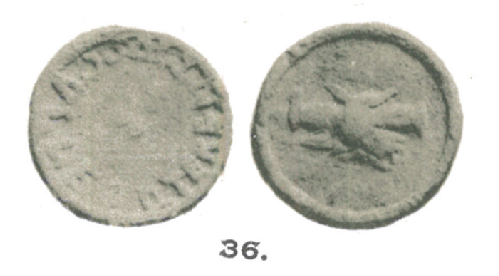 |
Two tokens from the Tiber assemblage: one carries images of a priestly staff (lituus) and an altar, the other the name of Q. Terentius Culleo and clasped hands.
The connection with tessera frumentaria was perhaps created because some of these objects carry the image of a modius with corn-ears; the idea then that these objects were used in corn distirbutions in Rome was an easy conclusion. But when one examines the assemblage from the banks of the Tiber more closely, this interpretation comes into serious question. Dressel published this assemblage, consisting of 487 lead tokens, at the beginning of the 20th century, and concluded that it may have been a hoard dated to around the middle of the first century AD. Examining the imagery of these tokens I was struck by the fact that many of the images chosen, including the modius, imitate or reference the design of Augustan and Julio-Claudian quadrantes, the smallest coin denomination at this time. Twenty-seven tokens carried a modius accompanied by the legend QAE and OPT (?) on either side (Rost. 383); these are 17mm in diameter, roughly the same size as a Roman quadrans.
 |
|
Quadrans of Augustus with clasped hands and moneyer's name.
© Trustees of the British Museum (R.6223)
|
From the same assemblage is a token (18mm) in the name of Q. Terentius Culleo showing clasped hands, a type also found on quadrantes under Augustus. Even the way Culleo's name is presented, around the outer edge of the token in a circle, imitates money of this period. Other tokens carry altars, a lituus, an eagle with open wings, and balanced scales. If you examine the iconography of quadrans from this period (available to view here), you'll find these same images. Given that these tokens came to light in the eighteenth century, its difficult to know for certain if this is a 'hoard'. But Dressel's conclusion, that this assemblage is likely to be the privately produced small change, is a good one given the similarities in imagery and size between these objects and officially produced quadrantes. Dressel believed the 'hoard' was the till of a merchant or innkeeper - the tokens found in highest quantity (carrying an altar on one side and lituus or priestly staff on the other, shown above, and which had 205 examples) were those of the owner; the other tokens were the differing currencies issued by other individuals in the region. It appears then, that in a localised area in Rome, small change may have been privately produced, and circulated alongside official currencies. Some of these tokens carried the imagery and titulature of Nero and Octavia. What does this mean for the imperial image? Its something I am going to work on in the future at an upcoming workshop in Durham.
While some tokens may have served as small change, others obviosuly had other purposes. Stay tuned for more revelations from the ERC-funded Token Communities in the Ancient Mediterranean Project!
Select Bibliography
Dressel, H. (1922). Römische Bleimarken. Zeitschrift für Numismatik 33: 178-183.
Ficoroni, F. (1740). I piombi antichi. Rome, Girolamo Mainardi.
Rostowzew, M. (1903). Tesserarum urbis romae et suburbi. St. Petersburg.
Virlouvet, C. (1995). Tessera Frumentaria. Les procédures de distribution du blé à Rome à la fin de la République et au débout de l'Empire. Rome, École française de Rome.
 Clare Rowan
Clare Rowan

 Please wait - comments are loading
Please wait - comments are loading

 Loading…
Loading…

